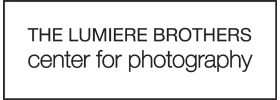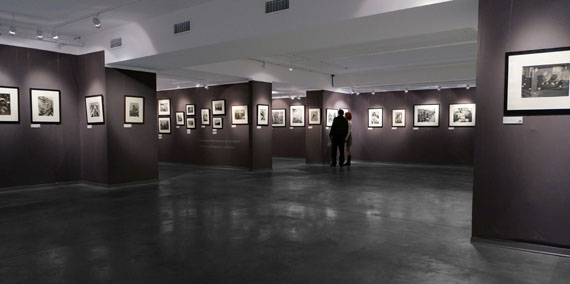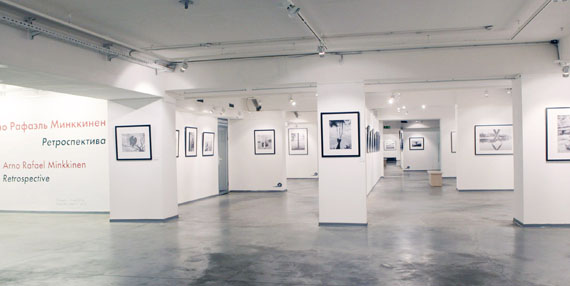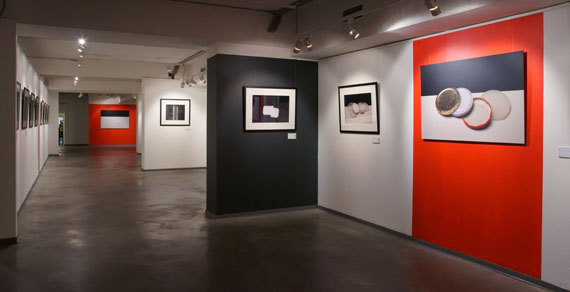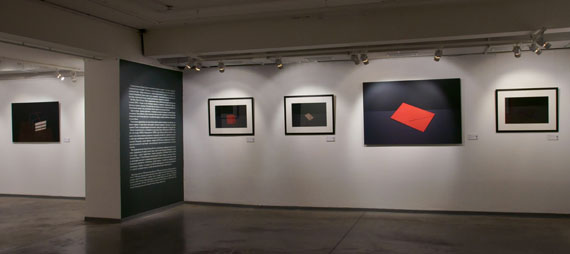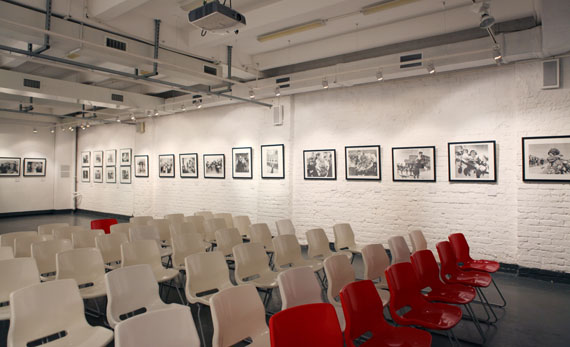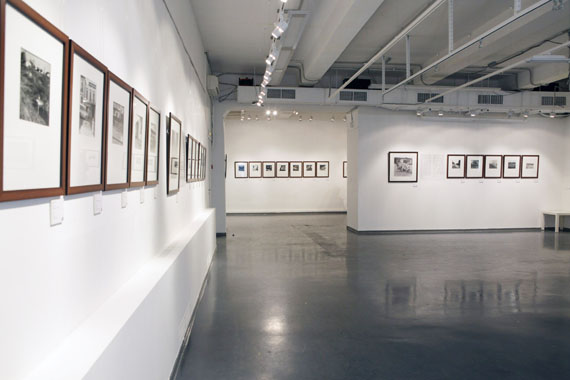Since its inception in 2010, the Lumiere Brothers Center for Photography has prominently positioned itself as one of the country’s leading photography venues, renowned for presenting an in-depth insight into Soviet and Russian 20th century photography and showcasing European and American artists of international standing. Located in the former chocolate factory Red October in the heart of Moscow, the Center comprises 3 halls and hosts around 18 exhibitions each year.
The exhibition program has been built around Center’s collection and its collaborations with contemporary photographers, private collectors, museums, and festivals, including partnerships with the Russian Museum and the Fotofest International Biennial, and is complemented by an extensive publishing program and education activities such as artist’s talks, panel discussions, and workshops. Committed to providing a wide range of perspectives on the Soviet legacy, the Center has been exploring particular photographic phenomena within their historical and cultural context, delving into a specific subject, period or body of work.The Center has had the privilege of exhibiting the works of avant-garde artist Boris Ignatovich and established photojournalists from the 1920s-1930s: Emmanuel Yevzerikhin, Yakov Khalip, and Arkadiy Shaikhet.
The programming has a strong focus on bringing to light postwar photography, which though has paralleled the development of European and American photography, has been left out of the international art scene due to a pervasive policy of censorship in the USSR. The thaw triggered the revival of reportage and flourishing of artistic tendencies, which stemmed from state-controlled photo clubs spread all over the USSR. While in the 1960s artists from photo clubs shifted from ideologically invested imagery to reportage, by the 1970s they turned to a more subjective approach in order to reach a deeper engagement with the subjects. A variety of styles and narratives of this period were explored in The Soviet photography 60-70 as well as in solo shows of selected artists. The 1970s also saw the rise of Kharkov-based artists, with their notorious figurehead Boris Mikhailov, that have been questioning the soviet political agenda by adopting an unorthodox language based on a witty interplay of text, ideological imagery, and performance. Their work was extensively presented in The act of disobedience.
Lithuanian artists mediated the social change of the 1960s-1970s through their distinctive visual tradition, coming up with a new mode of photography that gained its own standing in the Soviet art scene and has been acclaimed by international critics. By portraying daily routine of people from their native villages, they evoked archetypal Lithuanian characters and narratives. The Phenomenon of the Lithuanian photography school, Genius of the place gave insight into the work of these artists.
Transitional period of the 1980s -1990s saw the rise of politically sensitive art. Novokuznetsk-based group TRIVA, featured in PROzavod, has adopted a socially documentary approach in order to record unbeautified scenes of daily life. Moscow and St Petersburg underground artists, showcased in Time of bells, found an outlet for their expression in portraying gatherings of dissidents. During the turbulent 1990s photographers marked by a formal approach came to the fore. St Petersburg artists, featured in Silver City, Incomprehensible Petersburg, have been using photography as a way of communicating their emotional contact with the city, moving their work outside conceptual or narrative-based photography. Constantly testing the boundaries of the medium Moscow-based artist Vadim Guschin, showcased in Object. Function. Image., gravitated towards conceptual art by the 2000s.
In addition to its national focus the Center places a heavy emphasis on providing its audience with a broad range of international photographic work. The Center has showcased one of the forefathers of contemporary photography Williem Klein, figurehead of "environmental portraiture" Arnold Newman, eccentric street photographer Vivian Maier, established photojournalists Steve Schapiro, Sabine Weiss, Ruth Orkin, and Josef Koudelka, independent contemporary photojournalist Beat Schweizer, prominent West Coast photographer Wynn Bullock, conceptual artist Arno Rafael Minkkinen amongst others. �
The exhibition program has been built around Center’s collection and its collaborations with contemporary photographers, private collectors, museums, and festivals, including partnerships with the Russian Museum and the Fotofest International Biennial, and is complemented by an extensive publishing program and education activities such as artist’s talks, panel discussions, and workshops. Committed to providing a wide range of perspectives on the Soviet legacy, the Center has been exploring particular photographic phenomena within their historical and cultural context, delving into a specific subject, period or body of work.The Center has had the privilege of exhibiting the works of avant-garde artist Boris Ignatovich and established photojournalists from the 1920s-1930s: Emmanuel Yevzerikhin, Yakov Khalip, and Arkadiy Shaikhet.
The programming has a strong focus on bringing to light postwar photography, which though has paralleled the development of European and American photography, has been left out of the international art scene due to a pervasive policy of censorship in the USSR. The thaw triggered the revival of reportage and flourishing of artistic tendencies, which stemmed from state-controlled photo clubs spread all over the USSR. While in the 1960s artists from photo clubs shifted from ideologically invested imagery to reportage, by the 1970s they turned to a more subjective approach in order to reach a deeper engagement with the subjects. A variety of styles and narratives of this period were explored in The Soviet photography 60-70 as well as in solo shows of selected artists. The 1970s also saw the rise of Kharkov-based artists, with their notorious figurehead Boris Mikhailov, that have been questioning the soviet political agenda by adopting an unorthodox language based on a witty interplay of text, ideological imagery, and performance. Their work was extensively presented in The act of disobedience.
Lithuanian artists mediated the social change of the 1960s-1970s through their distinctive visual tradition, coming up with a new mode of photography that gained its own standing in the Soviet art scene and has been acclaimed by international critics. By portraying daily routine of people from their native villages, they evoked archetypal Lithuanian characters and narratives. The Phenomenon of the Lithuanian photography school, Genius of the place gave insight into the work of these artists.
Transitional period of the 1980s -1990s saw the rise of politically sensitive art. Novokuznetsk-based group TRIVA, featured in PROzavod, has adopted a socially documentary approach in order to record unbeautified scenes of daily life. Moscow and St Petersburg underground artists, showcased in Time of bells, found an outlet for their expression in portraying gatherings of dissidents. During the turbulent 1990s photographers marked by a formal approach came to the fore. St Petersburg artists, featured in Silver City, Incomprehensible Petersburg, have been using photography as a way of communicating their emotional contact with the city, moving their work outside conceptual or narrative-based photography. Constantly testing the boundaries of the medium Moscow-based artist Vadim Guschin, showcased in Object. Function. Image., gravitated towards conceptual art by the 2000s.
In addition to its national focus the Center places a heavy emphasis on providing its audience with a broad range of international photographic work. The Center has showcased one of the forefathers of contemporary photography Williem Klein, figurehead of "environmental portraiture" Arnold Newman, eccentric street photographer Vivian Maier, established photojournalists Steve Schapiro, Sabine Weiss, Ruth Orkin, and Josef Koudelka, independent contemporary photojournalist Beat Schweizer, prominent West Coast photographer Wynn Bullock, conceptual artist Arno Rafael Minkkinen amongst others. �
